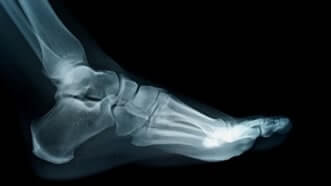Foot and Ankle Fractures Treatment in Farmington, MI

The foot is a complex structure composed of three parts: the forefoot, the mid-foot, and the hind-foot. It has many joints, muscles and bones of different sizes.
The ankle is a hinged joint which connects the foot with the leg. It is made up of three bones which are bound and supported by ligaments.
Bone fractures, or breaks, are common in feet and ankles. This is because they support the body’s weight and have constant force placed upon them while standing, walking, running, and jumping. Fractures can range from tiny cracks, called “hairline” fractures, to more complex and complete breaks in the bone.
Foot Fractures usually occur in the toes, the metatarsals (the five long bones at the base of each toe), the heel, or they can be stress fractures—which are hairline cracks in a bone due to repeated stress or overuse. Other causes of foot fractures include blunt impact, falling, severe bending of the foot, improper conditioning or poor footwear.
Ankle fractures are classified as either stable or unstable. With stable ankle fractures, the ankle joint remains stable despite the break, however, unstable ankle fracture compromises the position and stability of the ankle. Unstable ankle fractures may even involve an ankle ligament(s) and/or joint surfaces. Ankle fractures may be caused by severely twisting, rolling, or over extending the ankle, as well as direct impact, falling, overuse, poor conditioning/footwear, or osteoporosis.
Bone fractures in the feet or ankles may cause pain of varying degrees, swelling, or bruising. There may be an audible snapping or popping noise at the moment of injury, and it may be difficult or impossible to walk or put weight on the foot. With severe fractures, there may even be a protruding bone or deformity.
Treatment of a bone fracture begins with an examination by your podiatrist. They may need to see an X-ray to make an accurate diagnosis. Possible treatment of a bone fracture and associated symptoms include pain medication, rest, elevation, icing, offloading pressure, or realignment with a splint or cast. In some cases, repairing the fracture may require surgery and the bone may need to be stabilized with plates or screws, and casting or wearing a boot may be necessary for proper healing.
Since there are many small bones in the feet and ankles, it may not always be evident that a fracture has occurred. For this reason, it’s important to see your podiatrist as soon as possible if you notice lingering discomfort or pain in your feet or ankles.

